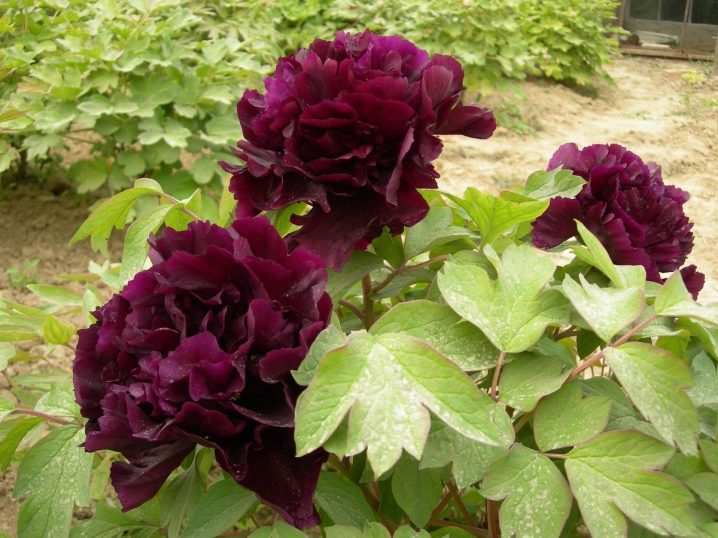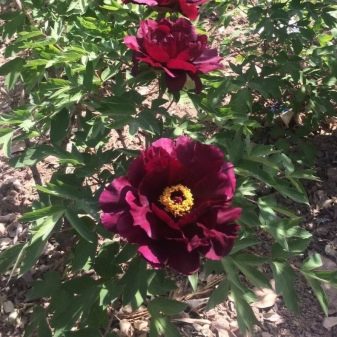All about dark and black peonies

From the end of May and throughout June, gorgeous flowers with large disheveled heads bloom in the gardens. Red, white, pink peonies attract everyone's attention, but plants with black or dark buds look especially elegant. And if the rose is called "the queen of flowers", then the peony can rightfully be called the "king of the garden."
Description
Among peonies there are herbaceous and tree-like plant species with powerful branchy shoots up to two meters high. Large carved leaves retain their decorative effect all summer, thanks to which the bush remains a decoration of the garden even after flowering.
The flower got its name in honor of the legendary physician Peon for its medicinal properties. Peony has been cultivated for more than 20 centuries, and until now, breeders receive new varieties of unusual colors.
Plants with black buds are very beautiful, which include flowers with a dark burgundy or purple color, which look like velvety black in the light. Such varieties look organically surrounded by white or pale pink inflorescences, but single bushes will look no less elegant.


Varieties
The modern classification of peonies divides all varieties into three groups.
The first group is called Japanese. It includes the most frost-resistant species with simple and semi-double flowers up to 200 mm in diameter and a bright, noticeable center of staminodes. Representatives of this group among dark varieties include the following.
- Tree hybrid "Black Panther"... The bush is about 2 m high, decorated with semi-double flowers of a dark red shade with a chocolate tint. The diameter of the blossoming bud reaches 180 mm.

- Delightful, very frost resistant, peony Roca "Black boy" also applies to treelike. The variety is distinguished by fast growth of shoots and large buds of dark red color up to 200 mm in diameter.


- Herbaceous Chocolate Soldier - a short bush with corollas of burgundy-beetroot petals, surrounded by bright yellow staminodes. Among the first to bloom, but has a slower growth.


Sino-European hybrids are distinguished by their special terry and large, up to 250 mm in diameter, flowers.
- Tree-like "Earley Black" with semi-double buds up to 250 mm in diameter, painted in a very dark burgundy with a brown-chestnut glow.
- "Black Pearl" - one of the best dark herbaceous hybrids. Shiny maroon petals of medium-sized buds, with a diameter of only 120 to 150 mm, look almost black and velvety in the sun, reminiscent of the “Black Prince” rose in color.
- Red charm - a herbaceous variety of American selection fully confirms its name "Red Charm". Lush bomb-shaped inflorescences with a light aroma bloom up to 200 mm in diameter and are colored dark red.
- Hybrid "Sacred Mountain" possesses large, very double flowers, saturated dark purple, almost black.
- Arboreal "Black Crown" belongs to the category of the darkest varieties. Buds up to 170 mm in diameter are painted in rich purple. The variety is quite winter hardy, requires shelter only in very cold winters.
- Beautiful purple-pink crown flowers of the Duck Black Ash variety up to 140 mm in size, they are among the first to bloom and are distinguished by abundant flowering.
- Herbaceous "Black hydrangea" delights with dark purple flowers in the shape of a ball with a diameter of 140 mm. The variety is classified as medium flowering.
- Hybrid "Black Dragon" refers to treelike.Its full name sounds like "Black dragon holding a magnificent flower." Large, up to 250 mm, cup-shaped buds are painted in a dark red with a lavender tint and have a light aroma.
- Dark rich burgundy color scheme of large, up to 250 mm, spherical colors varieties "Highlight" towards the end of flowering it changes to dark chocolate. Strong stems of the plant can hold up to three blossoming buds without additional support.




In the third group of tree hybrids of Yellow and Delaway peonies, dark varieties are absent, but some species have a dark burgundy or pink border.
Companion plants
Peony seedlings can grow in one place for many years, so it is important to choose the right site and plants that set off or emphasize the beauty of the flower.
Since peonies love sunlight, loose, non-boggy soils with a slightly alkaline reaction, you should avoid planting plants near larger ones, which will shade the bushes, accumulate moisture in the soil and interfere with the growth of new shoots.


Garden geranium looks best next to dark species, which compensates for the lack of flowers during the remaining summer time.
Small flowers of white tansy will fill the space around the bushes, resembling scattered pearls. Any undersized plants like violets, daisies, asters and many other species are also ideal.
Lilies will provide the perfect backdrop for flowering peonies, provided they are smaller in size than the "king of the garden" in full bloom.
For dark-toned hybrids, the white inflorescences in the background will provide the necessary contrast to accentuate the beauty and shape of the buds.

The difference in leaf shape between peonies and daylilies, phloxes or irises will be an exquisite addition to the composition.
Since the peony gets along with almost any neighbors, if they do not interfere with its growth, then there are a great many options for creating unique compositions, and it all depends only on the author's imagination.
You can learn more about dark peonies in the next video.







































































































The comment was sent successfully.